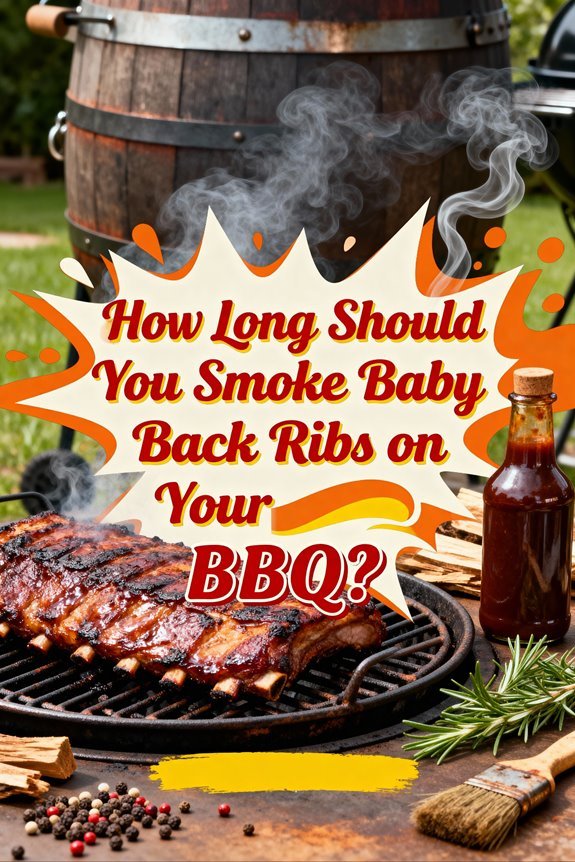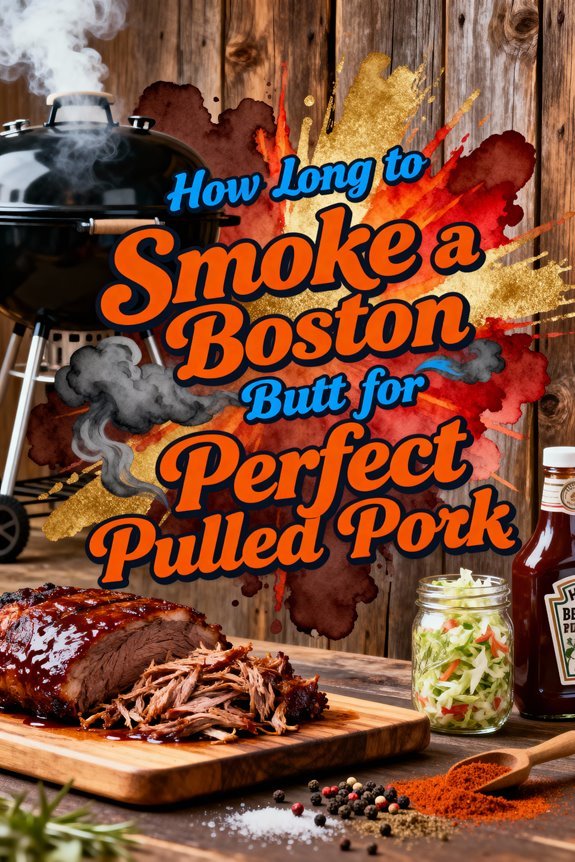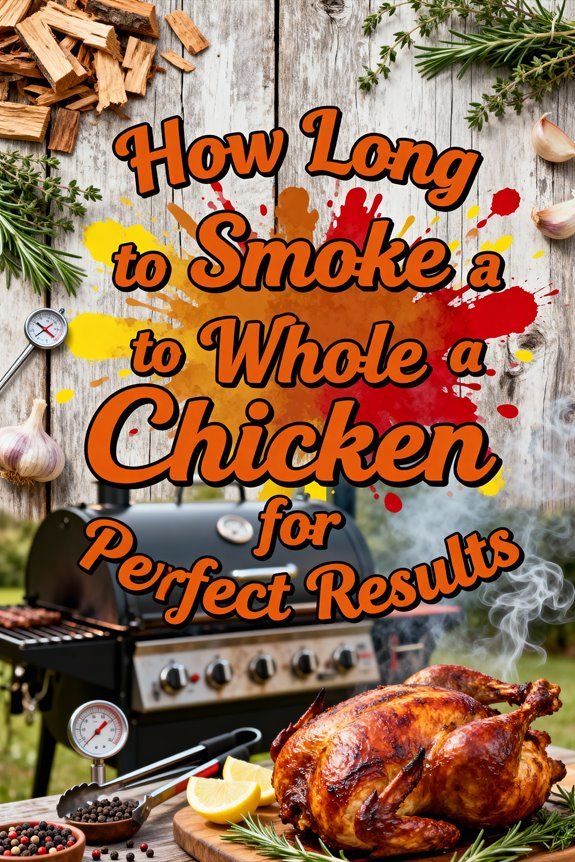You’ll need to smoke baby back ribs for 3 to 3.5 hours at 225°F to 250°F for ideal tenderness and flavor. The popular 2-2-1 method works perfectly: smoke unwrapped for 2 hours, wrap in foil for 2 hours to lock in moisture, then unwrap and glaze with sauce for the final hour. Always factor in an additional 30 to 60 minutes for setup and a 15-minute rest before serving. Your ribs are done when they reach an internal temperature of 205°F and pass the bend test. Continue below to master the essential techniques that’ll transform your backyard BBQ game.
Understanding the Ideal Temperature Range for Smoking Baby Back Ribs
When you’re smoking baby back ribs, the temperature range you select fundamentally determines your cook time and final texture. The standard range falls between 225°F and 265°F, with each increment serving a specific purpose. At 225°F, you’ll achieve maximum tenderness through extended exposure to smoke, though you’ll invest more time. The 250°F sweet spot balances efficiency with quality, making it ideal for baby back ribs’ leaner composition. Temperature factors like weather conditions, smoker type, and rib thickness demand adjustments to your baseline setting. Modern smoking techniques require precise temperature control—fluctuations compromise consistency. Your smoker’s ability to maintain stability, combined with reliable monitoring tools, guarantees even cooking throughout. Baby backs’ leaner profile demands lower temperatures than their St. Louis counterparts. A middle-ground temperature of 235°F produces ribs that finish in approximately 4 hours and 15 minutes. For optimal tenderness and bark development, monitor the meat until it reaches probe tender status with an internal temperature around 205°F. The 3-2-1 method provides a reliable framework for achieving perfectly tender ribs with a flavorful bark and caramelized finish.
Total Smoking Time: What to Expect From Start to Finish
Your baby back ribs require 3 to 3.5 hours in the smoker when you maintain temperatures between 225°F and 275°F, though this baseline shifts based on your equipment’s characteristics and environmental variables. Smoker efficiency directly impacts this timeline—pellet smokers hold heat differently than charcoal units, affecting overall duration. Meat thickness introduces another variable; thicker racks demand extended exposure while thinner cuts finish faster. You’ll need to account for additional time if you’re employing specific cooking methods like the 3-2-1 technique, which extends total time to six hours but delivers superior tenderness. A 250-degree setting produces excellent results with a total cooking time of approximately 4.25 hours, including the wrapped phase. Using hardwoods like hickory will impart a robust smoke flavor that complements the pork perfectly. Similar to smoking a Boston butt, you may experience a temperature stall where the internal temperature plateaus temporarily. Factor in 30-60 minutes for setup and a 15-minute rest period post-smoke. This resting phase proves critical for flavor development and juice redistribution throughout the meat.
The Three-Phase Smoking Process Explained
The 3-2-1 method breaks down your smoking session into three distinct phases, each serving a specific function in transforming tough rib meat into tender, flavorful results. You’ll spend the first three hours smoking unwrapped ribs at 225°F, allowing maximum smoke flavor penetration while the meat slowly breaks down. During phase two, you’ll wrap the ribs in foil with brown sugar, apple cider, and butter for two hours, creating a steam environment that guarantees moisture retention and accelerates tenderization. The final hour involves unwrapping and applying BBQ sauce, which caramelizes into a sticky glaze. For baby back ribs, you’ll want to adjust this to a 2-2-1 approach since their leaner composition requires less total cooking time to prevent drying out. Using this lower-temperature smoking method helps minimize the formation of harmful compounds compared to high-heat grilling. Baby back ribs come from the top of the rib cage, positioned between the spine and spare ribs, which explains their smaller size and leaner profile. You can confirm doneness when the meat pulls back from bones and reaches an internal temperature between 195°F and 200°F.
The 2-2-1 Method: A Popular Timeline for Fall-Off-the-Bone Ribs
For baby back ribs that deliver consistently tender results without overcooking, you’ll want to follow the 2-2-1 method—a 5-hour smoking timeline that’s become the gold standard among pitmasters. This technique comparison reveals why it outperforms the 3-2-1 method for baby backs: the shortened first smoke prevents drying while maximizing flavor enhancement. Similar to smoking chicken drumsticks, using indirect heat setup helps maintain consistent cooking temperatures throughout the process. Just like beef short ribs, using a probe thermometer is essential for monitoring the meat’s internal temperature accurately.
You’ll smoke your ribs unwrapped at 225–230°F for 2 hours meat-side up, wrap them tightly in foil with butter or brown sugar for 2 hours meat-side down to tenderize, then unwrap and sauce them for the final hour. The wrapping phase creates a steaming environment that breaks down connective tissue, while the last hour firms up the exterior and sets your glaze. Target an internal temperature around 205°F for ideal tenderness without mushiness.
After removing the ribs from the smoker, allow them to rest covered for 15 minutes before slicing to retain the juices and ensure the meat stays attached to the bone.
Spritzing and Wrapping: Timing These Critical Steps
While many beginners obsess over rub recipes and wood selection, mastering the timing of spritzing and wrapping will elevate your ribs more dramatically than any ingredient swap. Spritzing techniques begin after 90 minutes to 2 hours when the surface has dried and developed color. Apply a light mist—equal parts apple cider vinegar and water works perfectly—every 30 minutes until the 3-hour mark. This moisture helps smoke particles adhere and promotes bark development. Wrapping benefits become critical at this point: seal your ribs in foil to create a humid environment that tenderizes through steam while locking in flavor. The 2-hour wrapped phase transforms texture dramatically. After unwrapping, return ribs to the smoker briefly to re-crisp the bark if needed. Focus your spritzing on any brown areas and the entire surface to ensure even rehydration throughout the cook. Maintaining a consistent temperature range between 225° and 250°F throughout the entire smoking process ensures optimal results.
How to Tell When Your Ribs Are Perfectly Done
After your ribs have spent their time in the smoker through spritzing and wrapping phases, you’ll face the make-or-break moment: determining true doneness. Temperature readings provide your baseline—aim for 198°F to 203°F in the thickest part of the meat between bones, not touching bone itself. Similar to smoking brisket at 250 degrees Fahrenheit, monitoring internal temperature ensures optimal tenderness while maintaining efficiency. However, doneness indicators extend beyond temperature alone. Execute the bend test by lifting the rack with tongs; properly cooked ribs bend to approximately 45 degrees with slight surface cracking. For tenderness testing, insert a toothpick through the thickest section—it should slide through with minimal resistance. You’ll also notice ¼ to ½ inch bone exposure as connective tissue breaks down. The twist test confirms readiness when individual bones separate cleanly from meat. Baby back ribs are the most popular choice for grilling due to their leaner composition and concentrated meat above the bone. The 3-2-1 method offers a structured approach to achieve perfect tenderness through distinct cooking phases. These combined methods guarantee competition-quality tenderness.
Preparation Tips That Impact Your Smoking Timeline
For rub application, coat all surfaces including edges, then rest 15-30 minutes per side. This waiting period transforms dry seasonings into a wet glaze that adheres better during smoking, accelerating bark development. While waiting for the rub to set, you can arrange charcoal piles strategically for optimal heat control during smoking. Remove the membrane from the back of the ribs using a knife and paper towel before applying your rub. Many BBQ enthusiasts prefer using American-made pellets from Traeger’s USA facilities for authentic wood-fired flavor.







